New Ireland Masked Flying Fox
Common Name: New Ireland Masked Flying Fox
Scientific Name: Pteropus dastileti
Habitat: The New Ireland Masked Flying Fox is primarily found in the lush rainforests and coastal mangrove forests of New Ireland, an island in Papua New Guinea. This habitat features a diverse range of flora and fauna, providing the ideal environment for these bats to thrive. They are particularly dependent on mature forest areas and can be spotted in both lowland and montane forests, as well as surrounding coastal regions.
Physical Characteristics: The New Ireland Masked Flying Fox is notable for its impressive wingspan, which can reach up to 1.5 meters (approximately 5 feet). They have a distinctively colored fur, typically a mix of tawny brown and black, with lighter underbellies. Their face is characterized by a mask-like pattern, setting them apart from other flying fox species. They possess large eyes, which are adapted for low-light conditions, aiding in their nocturnal lifestyle.
Behavior: Typically social creatures, New Ireland Masked Flying Foxes live in large colonies that can number in the hundreds. They are known for their highly mobile flight patterns, enabling them to cover expansive distances in search of food. Their social nature is further reflected in their vocalizations, which include a range of clicks and calls. These bats exhibit roosting behavior during the day, often hanging together in trees to conserve body heat and avoid predators.
Diet: The diet of the New Ireland Masked Flying Fox mainly consists of fruits, nectar, and flowers. They play a crucial role as pollinators and seed dispersers within their habitat. Common food sources include tropical fruits such as figs, guavas, and other soft-bodied fruits that are abundant in their rainforest environment. This fruit-eating behavior significantly influences the growth and regeneration of various plant species in their ecosystem.
Reproduction: The reproductive habits of the New Ireland Masked Flying Fox include a single offspring typically born during the wet season, around November to December. Mothers are highly protective and nurture their young, often carrying them while they forage for food. The weaning period lasts for several months, with young flying foxes learning to fly and forage independently before reaching maturity.
Conservation Status: The New Ireland Masked Flying Fox is currently classified as vulnerable due to habitat loss from deforestation and hunting pressures. Conservation efforts are critical to ensure their survival, particularly as their unique ecological role is increasingly threatened by human activities.
Interesting Facts: An intriguing aspect of the New Ireland Masked Flying Fox is that they can consume large amounts of fruit in a single night, allowing them to disperse seeds over considerable distances. This behavior supports the health of their ecosystem and assists in maintaining biodiversity.
Role in Ecosystem: As important pollinators and seed dispersers, New Ireland Masked Flying Foxes play a vital role in their ecosystem. Their feeding habits help control plant populations and contribute to forest regeneration. Additionally, they serve as prey for various predators, thus maintaining the balance within the food web. Protecting their habitat is essential for sustaining other species that rely on the same ecological functions they provide.
